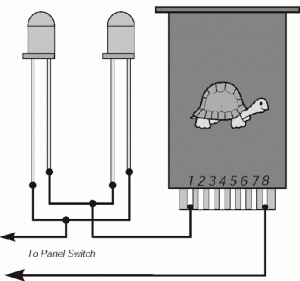I'd like to wire my tortoises (thrown with panel toggle switch) to two bicolor LED's, one for each track. So that when the switch is thrown, the 'open' track is green and the 'closed' track red...
Now, I THINK the easiest way to do this is to wire up to bicolor LED's per the standard wiring to a toggle (see image below). This, to my limited electronics ability, seems that they would be set in opposite... Voltage always going to the + of one (green) and the - of the other (red), giving the desired behavior.
Is that right? If not, how would I go about it?
Thanks,
Kris
Now, I THINK the easiest way to do this is to wire up to bicolor LED's per the standard wiring to a toggle (see image below). This, to my limited electronics ability, seems that they would be set in opposite... Voltage always going to the + of one (green) and the - of the other (red), giving the desired behavior.
Is that right? If not, how would I go about it?
Thanks,
Kris




